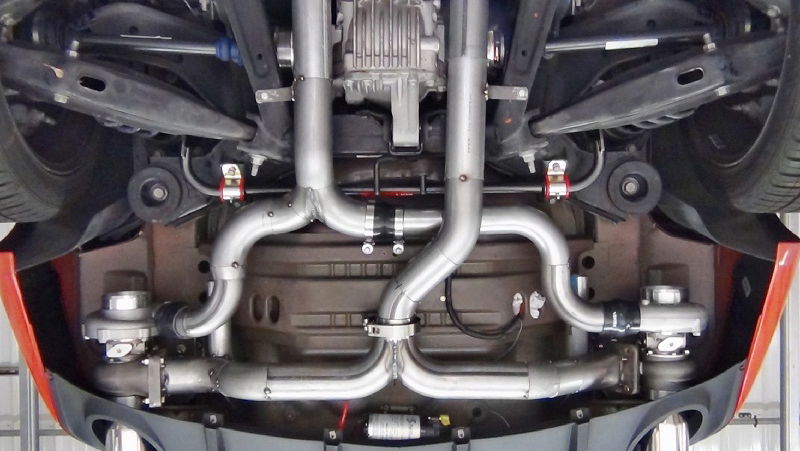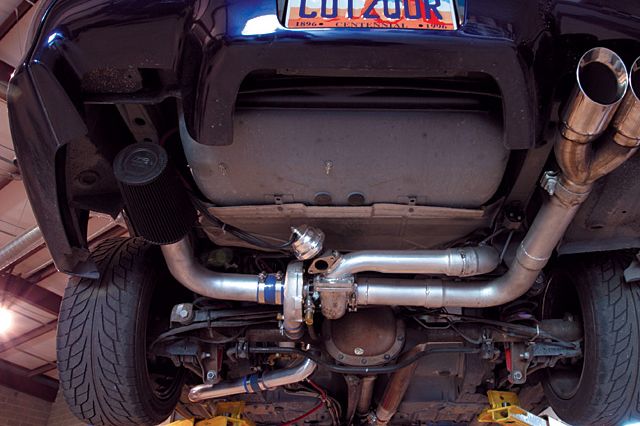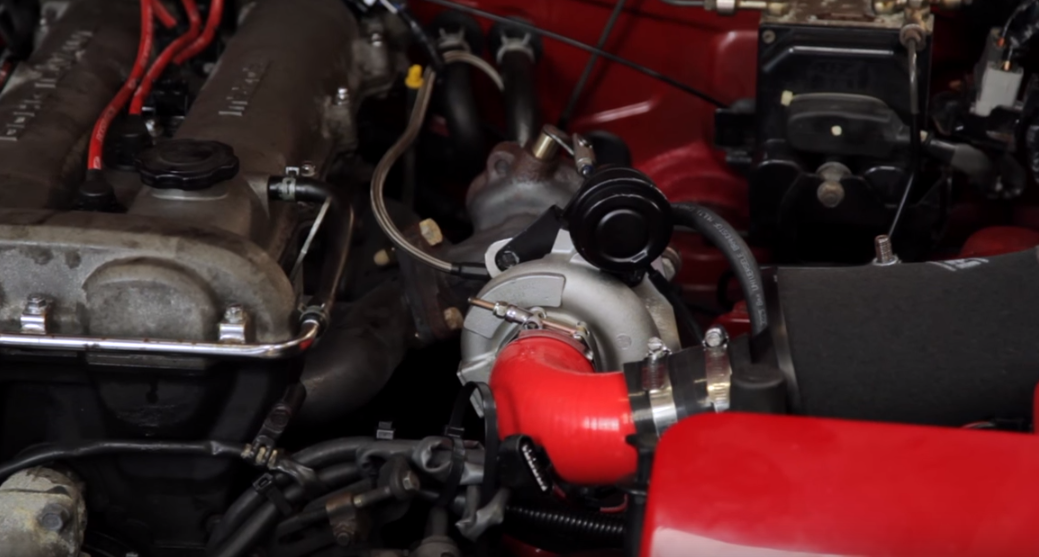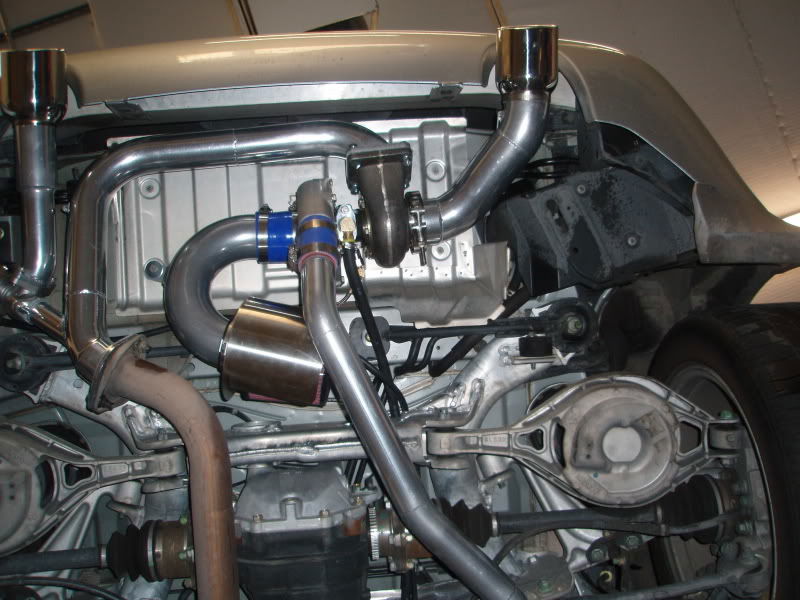What's Good And Bad About Rear-Mounted Turbochargers

Turbocharger placement - it’s an age old problem in the business of modifying car. Engine compartments can be cramped places, so fitting in one or more snails and all the associated parts isn’t easy.
An alternative placement for a turbocharger is to have it rear-mounted as part of the exhaust system, replacing the silencer/backbox with the turbine and multiple routes of additional tubing. Although these systems may look fairly impressive and offer what may seem like a bunch of advantages to a standard turbocharged system, is a rear-mounted turbo a genuine option?
Advantages
Seeing as the turbocharger increases the energy of the air by compressing it, the air exits the turbine in an extremely hot state which is normally where an intercooler comes in. Engines prefer colder, denser air to compress within the cylinders so intercooler are then used to cool the intake air to the engine from a turbo system. Having a turbo rear-mounted means that as the charge air from the turbocharger travels back to the engine, it is simultaneously cooled by the ambient air running underneath the car, saving the need for an intercooler.
The increased cooling effects also helps oil cooling, a very important aspect of reliable turbocharging. The oil circulating around the turbine is used for both the lubrication and cooling of the system - a lack of fluid can spell disaster for the turbocharger. The vast flow of cold air under the car will therefore help in keeping the oil cool and keeping the turbocharger operating smoothly.
It is estimated that a rear-mounted turbocharger will produce 260 degrees centigrade less heat build up than a front-mounted unit nestled in an engine bay. The huge amount of heat generated by a turbocharger can have an influence on other components nearby that don’t deal well with heat, like the engine block and engine cooling system, so rear-mounting takes away any possible effects of heat soak from a turbocharger to unwanted areas.
Disadvantages

Although all of those points seem to make a whole lot of sense, things aren’t all hunky-dory. First of all, there’s the sheer amount of tubing that has to be placed below the car to integrate the turbo. All of that compressed air from the turbo has to get back to the engine to be forced back into the cylinders, so intricate piping has to be put in place to achieve this.
This is also applicable for the oil system which will need a long feed from the sump to function properly, or a bespoke oil reservoir put in place to cope with the demands of the hot turbocharger.
Also, if all this tubing isn’t designed properly - with the right increases and decreases in diameter (especially to match the turbocharger inlet) - turbo lag will become a serious issue. With the turbocharger not being situated in close proximity to the inlet manifold, natural lag will be present as the compressed air has to travel further to reach the engine’s cylinders. Although this can be combated with a finely-tuned tubing system, most bolt-on kits will probably not be 100 per cent suited to your car’s powertrain.

Turbocharger efficiency can take a bit of a hit when compared to a standard engine bay placement or a hot-V setup. The intake air to the turbocharger will have cooled by the time it reaches the area once filled by the backbox as it travels down the exhaust system. As stated before, the turbocharger prefers nice hot air to function to its maximum capabilities, meaning that this natural cooling will reduce the turbine’s efficiency.
A turbocharger also thrives when large pulses of exhaust gases are sent through its inlet, but unfortunately these pulses will have decreased in size by the time they reach a rear-mounted system. This lack of pre-existing kinetic energy within the exhaust gas flow will further stump the turbocharger’s efficiency.

Forums are littered with arguments over rear-mounted turbo systems and whether they’re worth it, and in most cases the general rule is that they are not worth the hassle. The sheer amount of intricate plumbing needed to keep the system functioning properly is a hellish project to undertake and many of the cooling benefits are vastly outweighed by the lack of heat that a rear-mounted turbo would suffer from.
They may look dank, but I’d personally keep to the traditional engine bay cram, mostly because you don’t want that wonderful choo-choo to be wasted on everyone behind you!
Comment below with your thoughts on a rear-mounted setup, or if you already have one!
Comments
I asked engineering explained to do this so very long ago but Jason said nay lol
“In general, turbochargers should be placed in the hottest areas of an engine bay as turbine efficiency is proportional to the kinetic energy of the incoming air to the turbocharger fins. “
Maybe you meant that the turbocharger should be placed in the hottest part of the exhaust tract? Ideally you want the turbo to run cool on hot gases to reduce the need for a large intercooler.
Also there is risk that your hot side of turbo will crack if you run over puddle or catching hydrolock (if there is no protective shell on air filter)
I’d rather hook an oxygen bottle to the intake, force fed 100% oxygen to the engine. Imagine the power and efficiency…
I might have misinterpreted the first paragraph. But i don’t understand why the hotter the air the better?
I initially thought cold air contains more oxygen as opposed to hot air where the density of oxygen is lower. Please could anyone advise?
I also dont get how you drive it in the rain, the turo is HOT, and spilling cold liquid on it realy dosnt seem right
Honestly, I think I’ve never seen more bullshit in a single post.
I don’t want to throw a stone and then hide away, so I’m going to explain you why this is bullshit:
You don’t want to place your turbo in a hot place because placing a turbo in a hot place means having the compressor in a hot place. The cooler is the air, the better efficiency you’ll have regarding volumetric efficiency. You don’t really care about the turbine in this case, as the 99% of the heat won’t come from the heat delivered by the surroundings of the turbine; it will come from the combustion.
You will NEVER cool down the charge by air 260ºC degrees because even in a system without an intercooler, you would never reach more than 120ºC. Air will heat after being compressed in the compressor, and then it will usually travel through an intercooler, which usually will cool down no more than 50-60º, so the final temperature in the engine is usually 50º. A massive pipe traveling from a compressor in the back of a car will NEVER be by NO MEANS more effective than a intercooler, which is a part exactly designed for that.
The worst part of this system (engine at the front, turbo at the back) is that the pressure losses within both the turbine and the compressor are MASSIVE. It doesn’t make any sense to mount a turbo system in the back of the car, in the engine is not rear mounted. As simple as that.
Wait… if you can put turbos in the back then you can put twin in the front + rear then you have 4 turbos kicking in! #logic
Can i get downvotes for no reason
Pagination